The Benefits of Inclusive Leadership in the 21st Century

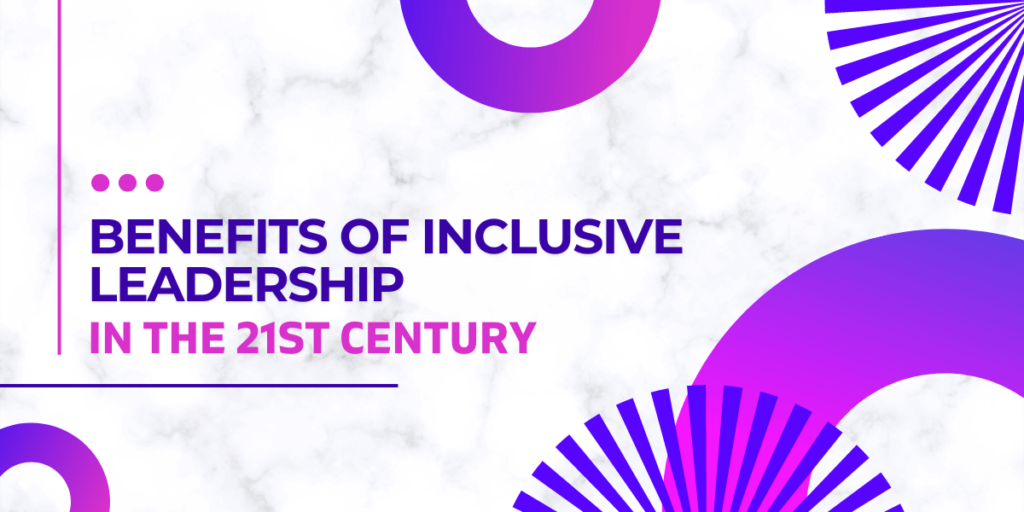
In today’s ever-changing world, demands for societal changes have increased, with calls to create more diverse and inclusive organizations. Research has shown that diverse and inclusive organizations outperform their peers, as they are 70% more likely to capture new markets. However, despite spending more than $8 billion a year on diversity programs, only some organizations have achieved their goal of becoming truly inclusive and diverse. The reason is that they overlook the most important factor: inclusive leadership. Inclusive leadership is rare, with only 5% of leaders globally defined as inclusive. However, inclusive leadership can be assessed, coached, and developed, and it’s essential to build diverse and inclusive organizations. Research suggests that companies that excelled at employee sense of inclusion reported a 17% get increase in perceived team productivity, a 20% increase in positive decision-making, and a 29% growth in collaboration rates.
What is Inclusive Leadership?
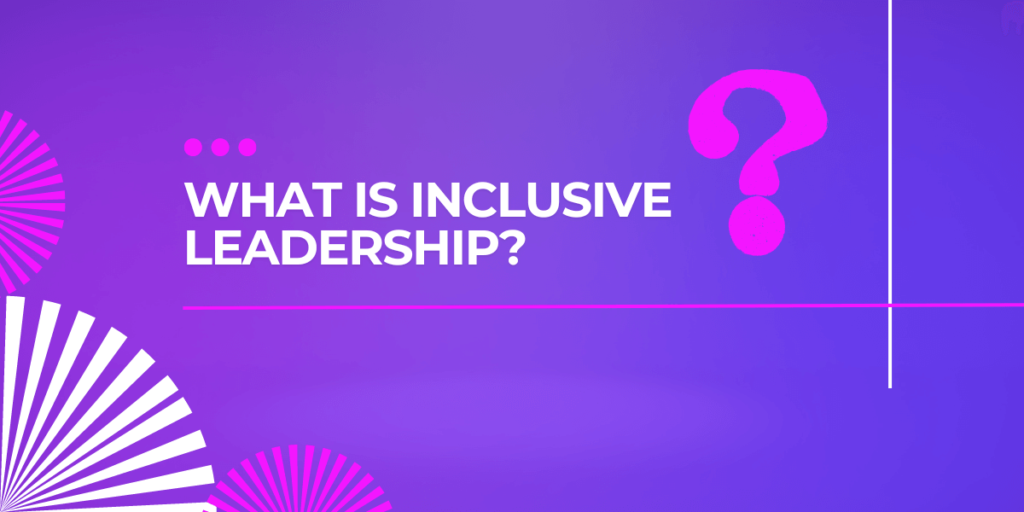
Inclusive leaders are those who interact with the diversity around them, build interpersonal trust, take the views of others into account, and are adaptive. These abilities increase their effectiveness and the impact they have on individuals, teams, and the organization as a whole. The five disciplines and five traits that define an inclusive leader are identified through fieldwork and analysis of over three million leadership assessments by Korn Ferry. Inclusion can also provide a competitive lead. Surveys exhibit that a company is 70% more likely to succeed in stabbing new markets when they have various and inclusive cultured companies.
Five Disciplines of Inclusive Leaders
In a research, 80% of the employees surveyed agreed that strengthening organizational leadership is crucial. Moreover, 87% of good-performing companies use project management systems (Wrike, 2015).
The following five disciplines describe an inclusive leader:
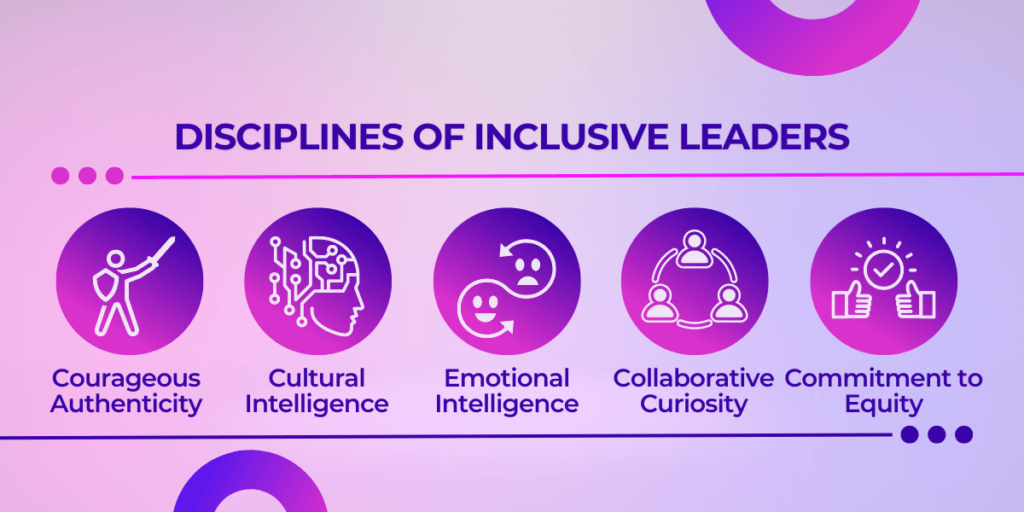
(i). Courageous Authenticity
Courageous authenticity involves being true to oneself and one’s values, while also being brave enough to speak up and challenge the status quo. This discipline requires leaders to have the courage to take risks, be vulnerable, and speak truth to power.
For example, an inclusive leader might be a CEO who speaks out publicly against discriminatory policies, even if it means putting their job on the line. They may also be willing to share personal stories of struggle or marginalization to connect with and inspire their team.
(ii). Cultural Intelligence
Cultural intelligence is the ability to understand and appreciate different cultural norms and values and adapt leadership styles to be more inclusive. This discipline requires leaders to have an open mind, be curious, and seek to learn about different cultures.
For example, an inclusive leader might take the time to learn about the different religious holidays celebrated by their team members and adjust work schedules accordingly. They may also learn about cultural communication styles to ensure they are effectively communicating with team members from different cultural backgrounds.
(iii). Emotional Intelligence
Emotional intelligence involves the capacity to identify and manage one’s own emotions, as well as understand and respond effectively to the emotions of others. This discipline requires leaders to have self-awareness, empathy, and the ability to regulate their own emotions.
For example, an inclusive leader might recognize when they are feeling frustrated or angry and take a step back to regulate their emotions before responding to a team member. They may also be able to recognize when a team member is feeling overwhelmed or stressed, and offer support or accommodations to help them manage their workload.
(iv). Collaborative Curiosity
Collaborative curiosity is the skill to actively listen and seek out different perspectives, and value the knowledge and expertise of diverse individuals. This discipline requires leaders to have an open mind, be curious, and actively seek out diverse opinions.
For example, an inclusive leader might hold focus groups or surveys to gather feedback from team members with diverse backgrounds and experiences. They may also encourage team members to speak up and share their ideas during team meetings, and actively listen to and incorporate their ideas into decision-making processes.
(v). Commitment to Equity
Commitment to equity involves a belief in fairness and justice for all, and a willingness to take action to promote diversity, equity, and inclusion. This discipline requires leaders to have a strong sense of social responsibility and a commitment to promoting equity.
For example, an inclusive leader might develop programs or initiatives to promote equity within the organization, such as mentorship programs or affinity groups for underrepresented groups. They may also advocate for policies or laws that promote equity and justice outside of the organization.
Get more out of your business
Get the best employee engagement content every week via mailing list
Five Traits of Inclusive Leaders
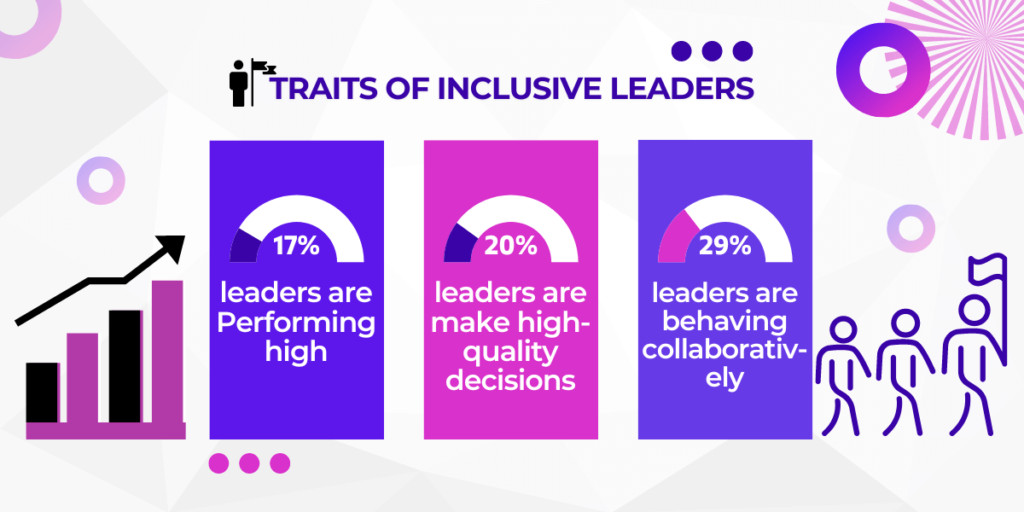
Study shows that inclusive leadership directly improves employee productivity. Teams with co-leaders are 17% more likely to report high performance, 20% more likely to say they make superior decisions, and 29% more likely to report collaborative behavior. Furthermore, we found that a 10% improvement in the concept of inclusion increases work attendance by about 1 day per year per employee, and reduces the cost of absenteeism.
The following inclusive leadership behaviors/ traits are demonstrated by inclusive leaders:
(i). Empathy
Empathy is a genuine interest and understanding of others’ experiences, perspectives, and feelings, and the ability to put oneself in others’ shoes. This trait requires leaders to be able to connect with and understand the needs and experiences of team members from diverse backgrounds.
For example, inclusive leaders might take the time to learn about the personal and cultural backgrounds of their team members, and seek to understand how their experiences have shaped their perspectives; of an inclusive culture. They may also seek out feedback from team members to understand how they can better support them.
(ii). Humility
Humility is an acknowledgment of one’s limitations and mistakes, and a willingness to learn from others. This trait requires leaders to have a growth mindset and be open to feedback and suggestions.
For example, inclusive leaders might admit when they make a mistake or don’t know the answer to a question and seek out feedback or guidance from team members. They may also be willing to learn from different experiences or backgrounds and acknowledge the expertise of team members who may have different perspectives.
(iii). Resilience
Resilience is the ability to recover quickly from setbacks and to persist in the face of challenges. This trait requires leaders to be able to navigate difficult situations and bounce back from adversity.
For example, an inclusive leader might be able to quickly adapt to changes in the business environment or manage unexpected crises. They may also be able to maintain a positive attitude and motivate their team in the face of challenges.
(iv). Courage
Courage is the willingness to take risks, speak up, and challenge the status quo to promote diversity, equity, and inclusion. This trait requires leaders to be willing to speak out and take action to promote change, even when it may be uncomfortable or unpopular.
For example, inclusive leaders might take a stand against discriminatory policies or behaviors within the organization, even when it may result in pushback or criticism. They may also advocate for policies or initiatives that promote diversity and inclusion, even when it may be challenging to implement.
(v). Visionary
One of the best inclusive leadership skills is to have a vision. Visionary is creating and communicating a compelling vision for an inclusive culture and inspiring and motivating others to work towards that vision. This trait requires leaders to have a clear sense of purpose and be able to communicate that purpose to others. To achieve overall organizational benefits, inclusive leaders understand the importance of creating a vision that makes leaders accountable, mobilizes resources, and guides decision-making.
Individual Benefits of Inclusive Leadership: Unlocking Potential
An inclusive workplace not only benefits the employees but also the organization as a whole.
You might already know that inclusive leadership is a management approach that seeks to create a work environment where all employees feel valued, respected, and heard, regardless of their gender, race, age, sexual orientation, or any other characteristic. By embracing inclusive leadership, organizations can unlock the full potential of their employees and create a more collaborative and productive workplace. Further, it can achieve a competitive advantage through inclusive work culture. Here are seven individual benefits of inclusive leadership:
1. Increased Engagement
Inclusive leadership encourages employee engagement, as individuals are more likely to be invested in their work when they feel valued and included. This can lead to increased productivity and better business outcomes. Further, inclusive environments also promote creativity and innovation, which can help organizations remain competitive in a rapidly changing environment.
2. Enhanced Creativity and Innovation

When people with different backgrounds and perspectives come together, they bring unique ideas and solutions to the table. Inclusive leadership encourages a diverse range of viewpoints, leading to enhanced creativity and innovation.
Analysis of 1,500 employees (2014), three-quarters showed innovation was among their company’s top 3 preferences. Even so, 83% saw their companies’ innovation potential as average (70 %) or weak (13 %).
3. Improved Problem-Solving
Inclusive leadership also fosters a culture of problem-solving, where employees feel comfortable sharing their ideas and perspectives to solve complex challenges. This leads to better decision-making and increased efficiency.
4. Greater Job Satisfaction
When employees feel valued and respected, they are more likely to have higher job satisfaction. This can lead to lower turnover rates and a more stable workforce.
5. Better Communication
Inclusive leadership also encourages open communication and feedback, leading to improved relationships and greater trust between employees and their managers.
6. Increased Loyalty
Employees who feel included and valued are more likely to be loyal to their organization. This can lead to a more committed workforce and improved retention rates.
7. Personal Growth and Development
Inclusive leadership also fosters personal growth and development, as employees are encouraged to learn from one another and expand their skill sets. This can lead to increased confidence and a greater sense of purpose at work.
In short, inclusive leadership can unlock the potential of individual employees and create a more collaborative and productive workplace. By embracing diversity and promoting inclusivity, organizations can reap the benefits of a more engaged, creative, and loyal workforce.
Team Benefits of Inclusive Leadership: Unlocking Collective Intelligence
Inclusive leadership is not only beneficial for individuals, but it also provides numerous advantages to teams. By embracing inclusive leadership, organizations can unlock the full potential of their teams and enhance their collective intelligence.
According to the Harvard Business analysis, inclusive leaders have teams where 29% tend to report high levels of collaboration and 17% would say they have high levels of productivity.
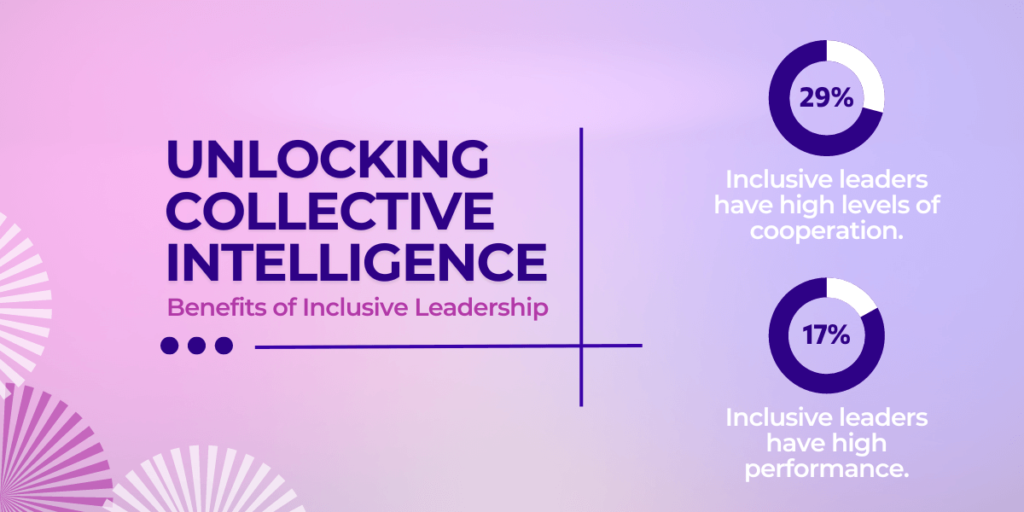
Here are seven team benefits of inclusive leadership:
1. Improved Collaboration
Inclusive leadership promotes a culture of collaboration and encourages teamwork. Teams that work together effectively can achieve more and produce better results.
2. Enhanced Creativity and Innovation
Teams that embrace diverse perspectives and backgrounds can develop more innovative solutions to complex problems. Inclusive leadership fosters a culture of creativity and innovation, which can lead to improved outcomes.
3. Greater Productivity
Inclusive leadership enables teams to work more efficiently and effectively. When teams feel valued and respected, they are more motivated to work together and produce high-quality results.
4. Higher Quality Output
Inclusive leadership can also lead to higher quality output, as teams can draw upon a wider range of skills and expertise. That is, according to a McKinsey report, well-connected teams see a 20–25% increase in productivity. When team members feel comfortable sharing their ideas and perspectives, they can produce more well-rounded and comprehensive work.
5. Improved Communication
Inclusive leadership fosters open communication and encourages teams to share their ideas and perspectives. This can lead to better communication, which can improve team dynamics and collaboration. According to a study (Connected culture), 71% of employees who said they were productive feel positively connected with their colleagues. Thus, regular employee connection is more productive.
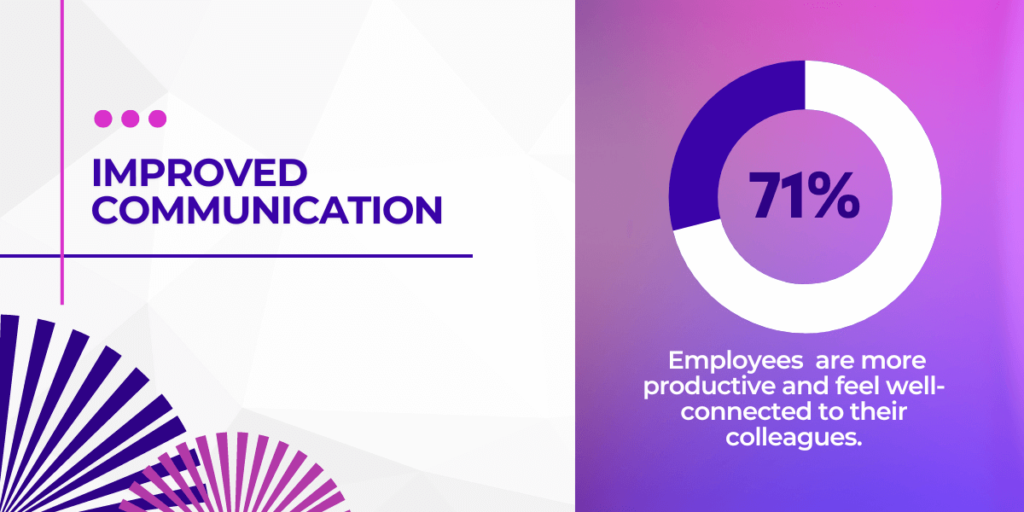
6. Increased Trust
Inclusive leadership can also lead to increased trust between team members. When team members feel valued and respected, they are more likely to trust one another, leading to better teamwork and collaboration.
7. Enhanced Learning and Development
Inclusive leadership fosters a culture of learning and development. Inclusive leaders utilize a diverse workforce and work on talent management to ensure that all team members are provided with opportunities for growth and development. An inclusive work environment encourages employees to use their skills and expertise to the fullest, leading to greater job satisfaction.
76% of millenarian conclude professional development opportunities are one of the most important elements of company culture.

Teams that work together effectively can learn from one another and grow together, leading to improved performance and outcomes.
To sum up, inclusive leadership can unlock the collective intelligence of teams and create a more collaborative and productive work environment. By embracing diversity and promoting inclusivity, organizations can achieve higher quality results, enhanced creativity and innovation, improved communication and trust, and increased learning and development.
How Inclusive Leaders can Unlock Potential and Intelligence
Inclusive leaders can unlock potential and intelligence in various ways. They encourage collaboration and value different ideas and opinions. They provide individuals with a sense of empowerment to take risks and reassure them that there is equity and fairness. They understand the importance of mentoring, sponsorship, and coaching, and they advocate for individuals who they think are being treated unfairly. They help individuals develop greater self-agency, encouraging them to speak up, be heard, and optimize their contributions. They also manage diversity skillfully by understanding the varying thought patterns and behaviors of diverse individuals and valuing them at a deep and personal level.
Conclusion
The benefits of inclusive leadership cannot be overstated. Inclusive leadership enables organizations to unlock individual potential and create an environment where all talent can thrive and grow. It unlocks collective intelligence and empowers diverse teams to outperform homogenous ones. Inclusive leaders are rare, but inclusive leadership can be assessed, coached, and developed. It is essential to build diverse and inclusive organizations, and inclusive leadership is the most critical factor in achieving this goal.


